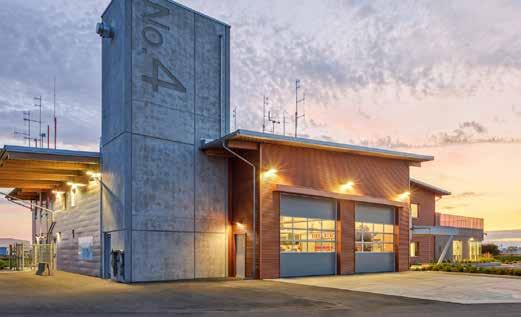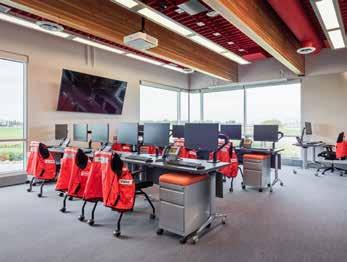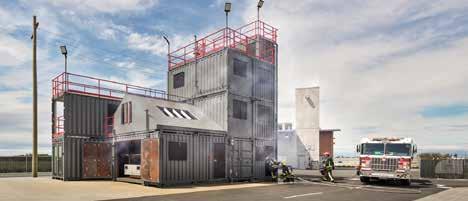
10 minute read
A NEW HOME FOR FIRST RESPONDERS IN DELTA, B.C
by MediaEdge
BY REBECCA MELNYK
Boundary Bay Fire Hall brings innovative wood design to growing industrial area.
Advertisement
Delta, B.C. is a wide-open landscape of quiet neighbourhoods and sprawling farms and migrating birds that gather near the coast of Boundary Bay. A network of three communities, combined with a population of about 100,000 people, the city is also home to one of the largest, developing industrial lands in the Greater Vancouver Area.
Wi t h t h i s g r o w i n g market near an airport and two provincial highways, a small, aging fire hall couldn’t keep up with the community’s emergency response needs. Also lacking was a proper emergency operations centre (EOC). During an event, such as a flood, rooms in city hall were cleared into makeshift workspace for 30 to 40 people overseeing different functions.
“When you’re dealing with disasters and emergencies, tensions are running high,” says Michel Latendresse, Delta deputy fire chief. “That doesn’t serve a one-room model where phones are ringing and people are trying to have private conversations.”
In 2019, the Boundary Bay Fire Hall was unveiled. Led by west coast firm Johnston Davidson Architecture, the facility blends wood design with human-centric, functional spaces. It brings together a multi-purpose satellite fire station, a live-fire training building, and a municipal EOC that flips into a corporate training facility, depending on the needs of the day. When not being used for emergency purposes, city staff reserve the rooms through a centralized booking system for training or meetings.
DISASTER READY
For Kimberley Johnston, principal at Johnston Davidson Architecture, function transcends into the structural elements, from controlling storm water run-off on a former greenfield site to choosing wood (80 per cent above grade) as a primary building material.
Using plywood sheeting and woodto-wood connections, the resilience of the design permits the facility to remain operational during a catastrophic event. More than aesthetic, large Glulam beams and post-disaster wood frames are visible in the structure throughout the interior millwork. Since the facility had to comply with post-disaster standards, withstanding 1.5 times the seismic forces of a regular building, the soil presented a challenge.
“Because of the liquefied soil on site, we had to create a really interesting raft slab foundation,” says Johnston. “If there was an earthquake and the soil liquified, the whole building would move. The thick slab allows for subtle movements found in seismic conditions, but it is also revealed on the main floor as a final finish throughout.”
Through her experience with wood design—more than 50 fire halls across Canada—Johnston found that integrating similar materials makes for good seismic conditions.
“Wood walls with wood roofs is a good combination; the building moves at the same rate during an earthquake,” she notes. “The tricky part is the way it’s put together; unlike your average house framing, post-disaster framing is much more intense. Getting people around that mind-set is always a challenge.”
Outside its durable qualities, Johnston says she really wants occupants to “feel the wood” because of its great health benefits. Research has long shown that

�The comfort of the facility extends into the kitchen, with natural wood cabinetry and cool water tones of a blue floor and grey countertops. The strict use of LED lighting throughout the entire hall takes on various forms, from long, linear pendant lights to under cabinet valences.

A municipal emergency operations centre flips into a corporate training facility, depending on the needs of the day.
visual exposure to natural materials like wood reduces stress and elicits feelings of comfort.
She believes as contractors become more familiar with the variety of wood products and how they remain viable outside the residential realm, this will open the door for more trades and a larger workforce on a project, which helps with better bidding.
To ensure a fast and cost-effective process on the new fire hall, the designers worked alongside the subtrades through a series of digital meetings, zoning in on close sections of the building model to refine crucial details before the wood elements arrived on site. Earning a 2019 Wood Design & Building Award in the Canadian Wood Council Award category, Boundary Bay Fire Hall is helping to bring mass timber into the mainstream.
“Speed, innovation and technology have made a huge difference in how people understand where to use wood,” says Johnston. “Where once it was seen as a residential product, it’s now moving into larger institutional and civic projects.”
RISKY BUSINESS
Outside the fire hall, crew members learn how to control modern-day fires in a very modern structure—a fourstorey burn building fashioned from steel shipping containers. The lego-like, modular design houses a flexible interior for live-fire scenarios with balconies, rooftops and confined spaces. Skills are honed in a simulated, pollution-free environment with natural gas as a heat source and theatrical smoke. Props can be operated remotely from a separate control room.
“With the advent of building construction and modern technology and early detection systems, fires are becoming less common,” says Latendresse. “But the risk to firefighters is becoming greater because they’re not practicing as often.”
When fires do occur, he muses, they’re larger and complex. Soundproofing and air tightness are causing more confined buildings. Synthetic materials are more toxic, and heat can quickly build up if an early detection system isn’t in place. Delta Fire & Emergency Services helped inform the burn building design, as well as the mechanical building systems inside the hall itself.
Fire halls require highly specialized systems that must meet code requirements and energy efficiency standards. It can often be tricky to blend the objectives of an engineer and architect with a facility that works for the firefighters.
“That’s one thing we can never lose sight of,” says Johnston. “You want to be concerned with aesthetics, sustainability and energy efficiency, but it can’t be at the cost of functionality. We worked really hard to blend those elements.” | CFM&D
PHOTOS BY JOHNSTON DAVIDSON ARCHITECTURE

Fashioned from steel shipping containers, the four-storey burn building features a flexible interior for live-fire scenarios with balconies, rooftops and confined spaces.
BY MOUNA HANNA
PROTECTIVE ACTIONS
Facility managers play several roles to ensure a building runs efficiently. They interact with building owners, third party independent contractors and tenants on a daily basis. As a result, they are often confronted with various legal issues. Here are the most common.
SLIPS, TRIPS AND FALLS
Unfortunately, slips, trips and falls are a common occurrence, especially in winter. Whether responsible for a residential or commercial property, facility managers should ensure they are taking proper steps to protect themselves and the building’s owner in the event of a personal injury lawsuit.
Owners and occupiers of properties are subject to the Occupiers’ Liability Act, which requires that they take reasonable care to ensure building occupants and guests are safe while on the property. The key is they act ‘reasonably,’ not ‘perfect.’ Recordkeeping is important. Facility managers should accurately and diligently document all efforts undertaken to make the premises safe. If there is a slip, trip or fall on the property, they should investigate immediately, gather information, speak to witnesses and take photographs as soon after the incident as possible.
These records and photographs should be kept for at least two years after the incident, as an injured person generally has this long to commence a lawsuit. These records will help defend against allegations of negligence if the claimant tries to exaggerate how ‘dangerous’ or ‘hazardous’ the property was when the incident occurred.
INDEPENDENT CONTRACTOR CONSIDERATIONS
Where the services of an independent contractor, such as a winter maintenance company, security provider or building maintenance contractor, are engaged, facility managers should consider whether the contract adequately protects them in the event of a lawsuit arising from the independent contractor’s negligence. This contract should outline each parties’ responsibilities and who should be held accountable if something goes wrong.
Facility managers should also consider an indemnity and hold harmless agreement with their subcontractors, so that if there is a lawsuit, the subcontractor would be required to defend and indemnify building ownership and facility management.
They would be wise to require their subcontractor to name them as an ‘additional insured’ on their insurance policy as well, and to provide them with a copy of the certificate of insurance before commencing any work at the property.
LEGAL CANNABIS USE
The possession, use and sale of marijuana has been legal in Canada since October 2018. In many provinces, smoking marijuana in public spaces is not permitted, so an individual’s only option is to smoke at home, which is generally allowed even though it may be a nuisance to neighbouring residents and there’s an increased risk of fire or property damage.
Despite legalization, the use of marijuana can be prohibited in a building, either in the lease agreement or with the passage of condominium bylaw (with the necessary votes). Where smoking has not been prohibited in a building or unit, facility managers may be confronted with complaints from occupants regarding the bothersome smell, second-hand smoke, air quality and even an aggravation of their health conditions. If these complaints and concerns are not taken seriously, it may expose the facility manager to a lawsuit. Facility managers should consider implementing an odour control strategy and system to balance an occupant’s right to lawfully consume marijuana with another’s concern about their health, well-being and enjoyment of their unit.
ATTACKS ON PRIVACY
Cyberattacks against facility management companies have been growing in number over the past few years. These can range from ransomware viruses, where a company’s computers, security systems and IT systems are encrypted and held for ransom, to a social engineering attack,
where a hacker infiltrates a company’s e-mail account and diverts important communications, often causing financial harm. Cyber criminals have also extorted facility management companies by hacking their websites and threatening to disclose tenants’ personal information on the internet if the company does not pay a large sum of money.
This raises serious concerns from a legal perspective, as a facility manager is required to protect tenants’ personal information from unlawful access, use or disclosure, pursuant to the Personal Information Protection and Electronic Documents Act. As of November 2018, if a tenant’s personal information is unlawfully accessed, used or disclosed (for example, by a hacker or even a rogue employee), a facility manager is required to notify the affected tenants and Canada’s privacy commissioner if there is a ‘real risk of significant harm’ to the tenants. This type of notification inevitably leads to a risk of legal action and potentially a class action lawsuit.
Facility managers should turn their minds to updating their cybersecurity strategies in light of increasing cyber attacks. They should also develop an incident response plan in the event they are confronted with a cyberattack or incident involving a breach of a tenant’s privacy.
HUMAN RIGHTS CONCERNS
Pursuant to the Human Rights Code, it is illegal for a landlord, facility manager or another occupant to discriminate against or harass a tenant on the basis of a protected ground, including age, colour, religion, disability, marital status, receipt of public assistance and sex (including sexual harassment, pregnancy and breastfeeding), among others. Facility managers have a legal responsibility to take steps to ensure discriminatory harassment stops if they receive a complaint from a tenant. Where they ignore or fail to do anything about it, there is a risk the tenant will file a human rights complaint.
Facility managers are also required to provide accommodations to tenants to the point of undue hardship. For example, types of accommodations could include changes or renovations to building entrances, sidewalks or parking areas; accommodating a request for a ground level unit; providing a spiritual or multi-faith room where tenants can go to pray. A facility manager should evaluate each request or complaint on its merits, having regard to the fact each tenant is guaranteed equal rights and opportunities under the law.
The article does not constitute and is not intended to be legal advice. It provides general considerations that require further exploring. | CFM&D
Mouna Hanna is partner at Dolden Wallace Folick LLP in Toronto, where she routinely defends building managers, property owners and independent contractors in civil actions. She also co-leads the cyber and privacy practice group. Mouna can be reached at 647-798-0615 or mhanna@dolden.com.

From Boiler Room to Boardroom

A professional association focused on advancing and promoting the FM community. Join IFMA Toronto Today at ifma-toronto.org





